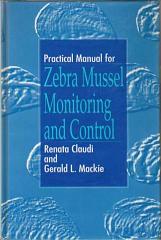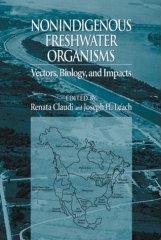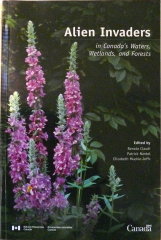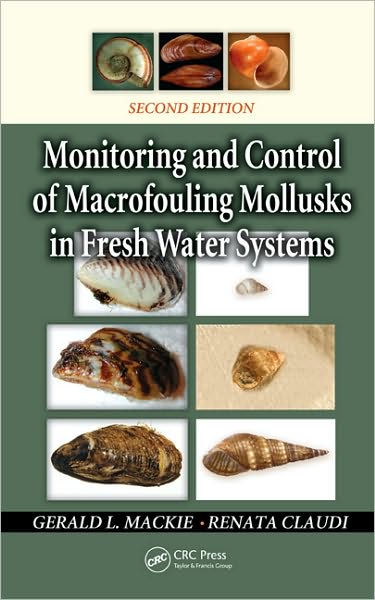Practical Manual for Zebra Mussel Monitoring and Control
by Renata Claudi and Gerald L. Mackie
|

|
Since its introduction to the Great Lakes system in 1985, the zebra mussel has spread
so rapidly that it is now considered the most serious biofouling pest of any exotic
species. Practical Manual for Zebra Mussel Monitoring and Control will help
you counter this threat by leading you through the events you will be faced with
when dealing with this biofouler. This book is a crucial source of detection, monitoring,
and control methods. It also provides thorough discussions regarding the mussel's
biology and potential for harm. Learn how to:
- Determine if your facility is in danger of infection
- Distinguish zebra mussels from other pest species
- Detect the first appearance of larvae and adults
- Monitor the growth and abundance of the mussels
- Choose proper control methods and monitor their success
- Minimize costs
The book presents a "fast-track" approach for handling current zebra mussel problems
as well as a "slow-track" approach for avoiding potential problems. No other book
offers so much information designed to help you avoid excessive down-time due to
macrofouling. If you are an engineer, technician, or operator at a power utility,
industry, or water/wastewater treatment plant, this manual is a "must-have" book.
Link to book on Amazon.ca
|
Nonindigenous Freshwater Organisms
by Renata Claudi and Josheph H. Leach
|

|
Alien species invade aquatic ecosystems through both intentional and accidental
means. The voluntary introduction, if performed at all, is usually monitored by
professionals who have made a risk assessment. Accidental incursion is more difficult
to control and poses a potentially grave threat if left unchecked or undetected.
Nonindigenous Fresh Water Organisms focuses on this infringement in North American
aquatic ecosystems. The 31 chapters measure the devastating ecological, and sometimes
economic, impact caused by the encroachment of immigrant species.
The book includes case studies such as the Zebra mussel, which arrived in the Laurentian
Great Lakes via the ballast of a foreign ship. There is a section for each pathway
of introduction, which includes a chapter devoted to its North American history
and an analysis of the potential harm caused by further intrusion. The final portion
of the book is devoted to a prediction methodology for the success or failure of
an introduction. The chapter on risk assessment is especially useful for the planning
of a voluntary introduction.
Link to book on Amazon.ca
|
Alien Invaders in Canada's Waters, Wetlands and Forests
by Renata Claudi, Patrick Nantel and Elizabeth Muckle-Jeffs
|

|
Invasive alien species are a recognized global threat to biodiversity, and their
costs to agricultures, forestry, fisheries, and public health are thought to be
enormous. No comprehensive overview exists of the invasive alien species issue in
Canada. Alien Invaders in Canada's Waters, Wetlands, and Forests aims to
bridge this gap. It is a collection of papers from experts in several disciplines
who discuss and analyze invasive species from a variety of perspecives: invasion
pathways, affected sectors, management and control, and national and international
collaborations.
Renata Claudi, MSc, an acknowledged expert on macrofouling and aquatic nuisance
species, spearheaded the development of the publication. Patrick Nantel, PhD, is
a Canadian Forest Service science advisor and plant ecologist. Elizabeth Muckle-Jeffs
is a communications expert and associate of The Professional Edge.
Link to Publisher
|
Monitoring and Control of Macrofouling Mollusks in Fresh Water Systems,
2nd Edition
by Gerald L. Mackie and Renata Claudi
|

|
Upon its initial publication more than fifteen years ago, this book broke new ground
with its comprehensive coverage of the biology and ecology, distribution and dispersal
mechanisms, physiology, monitoring, negative and positive impacts, and control of
aquatic invasive species of mussels, clams, and snails. Building on this foundation,
the second edition of Monitoring and Control of Macrofouling Mollusks in Fresh Water
Systems includes completely revised information on species such as the zebra
mussel while also covering up-and-coming nuisance species such as the quagga mussel,
Conrad's false mussel, the Asian clam, and the fast-spreading golden mussel.
The second edition includes:
- Ten new species of mussels and snails
- International case studies on mussel fouling problems and how to cope with them
- New control and monitoring techniques
- Discussions of the latest threats and possible future scenarios
The book contains brief descriptions of the external and internal structures, examining
only those features relevant to the monitoring and control of the invasive species.
It discusses why the mollusks are pests, distinguishing nuisance species from native
species, their habits and habitat, reproductive potential, and life cycles and population
dynamics. The authors also explain how efficient dispersal mechanisms employed by
the nuisance mollusks not only help them spread so rapidly to inland lakes and rivers
across continents, but how they can invade virtually every part of a facility.
While many other resources contain segments of this information, none cover all
areas and link them in a cohesive fashion. It is this approach that makes the understanding
of potential impacts on ecosystems, industries and utilities, as well as the many
human-made physical and chemical mitigants for controlling the mollusks supplied
by this book so crucial for preserving the health of raw water supplies.
Link to Publisher
|